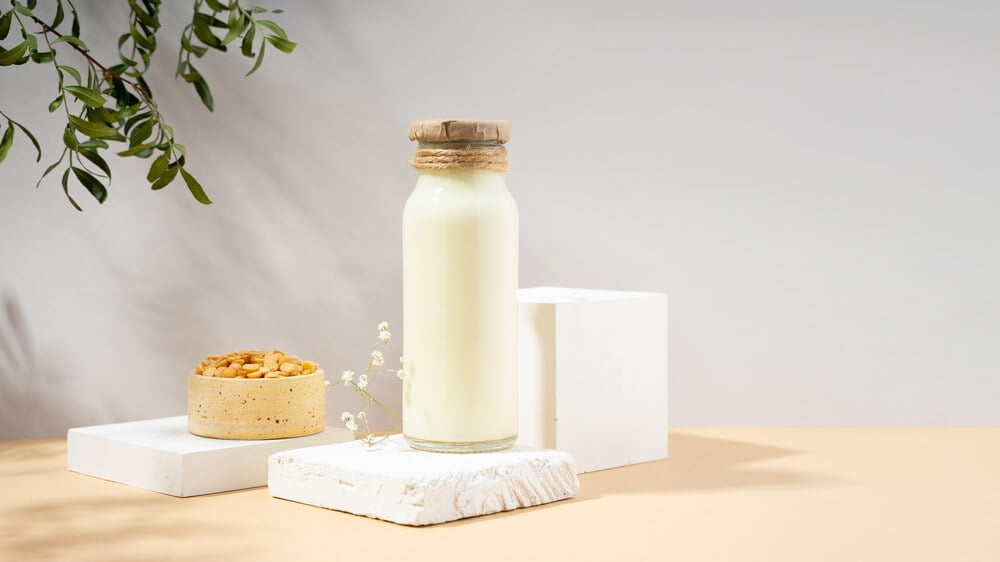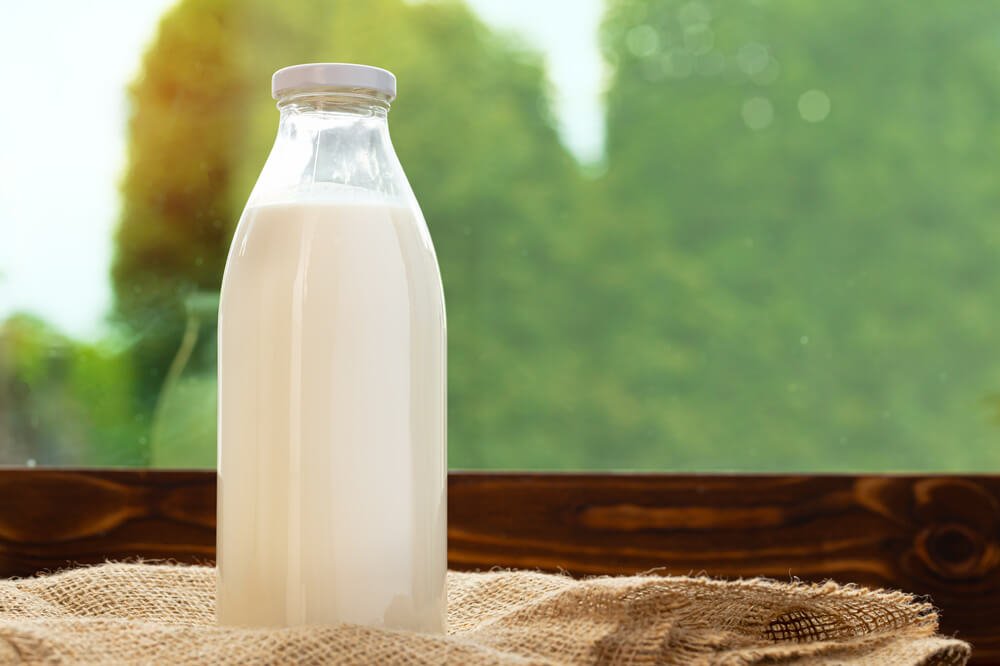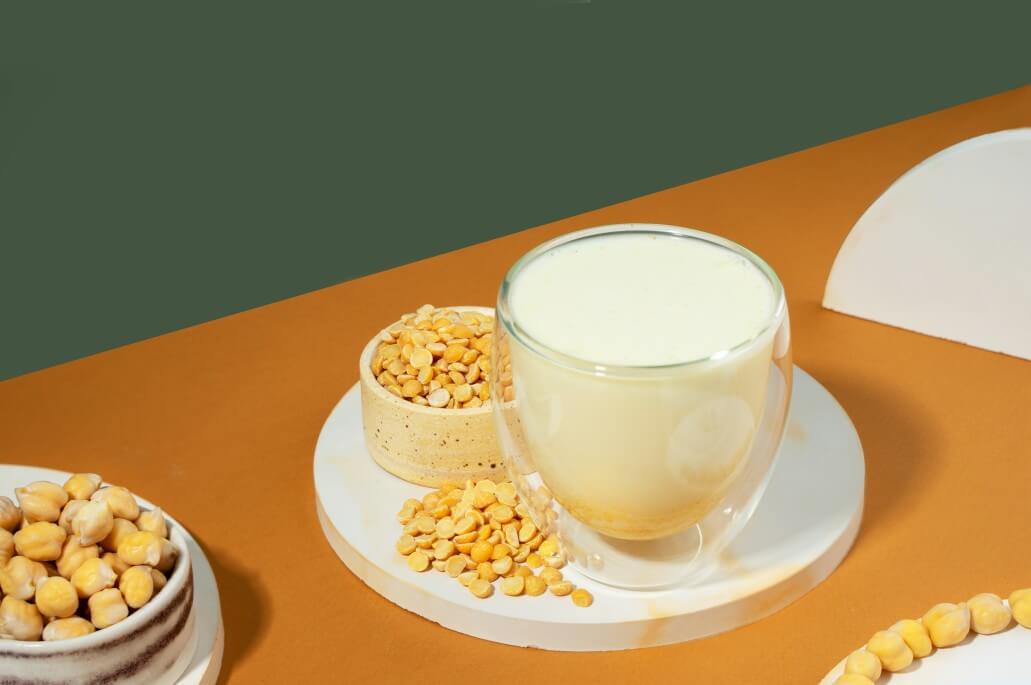Pea Milk
Protein
Pea milk has one of the highest amounts of protein of any non-dairy milk.
Allergen-Free
Pea milk is free of nuts, soy, gluten, and other common food allergens.
Sustainable
Peas require less fertilizer and water than many other plant-based milk crops.
Pea milk is a more hypoallergenic milk alternative derived from peas.
It's low carb, high in protein, and very nutritious.
On top of that, the general census is that pea milk tastes more like cow's milk than other milk substitutes. Plus, you can use it in place of milk in most recipes.
In the following guide, we share even more unique benefits of this lesser-known non-dairy milk including how to make pea milk at home.
Read on to learn everything about pea milk.
What is Pea Milk?
Pea milk is derived from peas to serve as a substitute for milk. Like other milk substitutes, it's primarily intended for people who are unwilling or unable to consume dairy. Thus, it contains no dairy or lactose whatsoever.
It's also free of several allergens that are very prominent in other milk alternatives. There are no soy or nut ingredients, nor any gluten.
This makes pea milk the best choice for those with extreme food sensitivities/dietary limitations.
How Is Pea Milk Made?
When you hear the name, "pea milk," you most likely think of green peas—or even split-pea soup.
In reality, pea milk uses yellow peas, which are more commonly grown outside the U.S. Also, it's not simply mashed-up peas or pea juice.
To make pea milk (commercially), peas are blended with water and strained. Then, sometimes the milk is fortified with other ingredients to improve the flavor, taste, and nutritional content.
What Is Pea Milk's Flavor & Consistency?
More importantly, is pea milk any good? Well, that's sort of up to the individual.
As far as texture goes, it's generally considered superior to other milk substitutes. It has a thick creamy, milk-like consistency. Most people prefer this over the thinner, more watery consistency of almond or soy milk.
The taste of pea milk is also a matter of opinion. Many will tell you that it tastes more like milk than other dairy-free alternatives. But some complain that the taste is unfavorably bitter.
Pea Milk Nutrition Facts
Here are the nutrition facts for 1 cup of unsweetened pea milk.
Pea Milk Nutrition Facts | |
|---|---|
Calories | 79 |
Protein | 8g |
Fat | 5g |
Carbohydrates | 2g |
Fiber | 0g |
Sugar | 0g |
Trans Fat | 0g |
Saturated Fat | 1g |
Sodium | 139mg |
Calcium | 451mg |
Potassium | 470mg |
As you can see there's a decent amount of protein, vitamins, and minerals in pea milk. And it's cholesterol-free.
Keep in mind, though, that this is only one specific pea milk product. And it's fortified with vitamins and other added ingredients.
Pea milk is a manufactured/processed food. Each company that produces it has a unique formula/method for doing so. So, the nutritional content of pea milk varies by brand and product.
The Benefits of Pea Milk
Now, how does pea milk compare to your other options? To answer that let's look a little closer at the health benefits and other advantages of pea milk.
It Supplements Dairy Milk's Most Important Nutrients
Dairy milk contains important nutrients our bodies need. Thus, cutting all dairy products from your diet all at once can be dangerous. To avoid health problems, you need to replace the nutrients you'd otherwise get from dairy.
Being a milk substitute, pea milk is fortified to include many of these missing nutrients. Pea milk has approximately the same amount of protein and calories as dairy milk. But milk has far more carbs, sugars, and cholesterol.
The vitamin and mineral content depends on the particular pea milk product you buy. But most pea milk manufacturers aim to include comparable amounts of these nutrients, too.
It's Great For Almost Any Diet
Food allergies, medical conditions, weight goals, and even your belief system can place restrictions on your diet. Luckily, pea milk is considered acceptable in almost any specialized diet plan.
Allergen-Free
According to Healthline, the most common food allergies are:
- Dairy
- Eggs
- Peanuts/tree nuts
- Fish
- Shellfish
- Soy
- Wheat
This list prohibits many people from consuming milk, almond milk, or soy milk. Alternatively, there are far fewer people who are allergic to peas. Plus, the additional ingredients in pea milk are generally hypoallergenic, too.
Animal-Free
Are you vegetarian, vegan, or otherwise avoiding animal-derived products? Those who are may consume pea milk guilt-free.
Producing pea milk requires no animal ingredients. Though, make sure you check the label of any premade pea milk products.
Low-Carb
If you're counting carbs to reach your weight-loss goals, switch from dairy milk to pea milk. As mentioned, unsweetened pea milk is significantly lower in carbs than dairy milk—about 6 times lower, to be exact.
Low-Calorie
1 cup of unsweetened pea milk is just about 80 calories. Although that's the same as a cup of skim dairy milk, pea milk calories are sugar-free (unless sweetened). Thus, pea milk gives you a low-calorie protein boost and energy that won't make you crash later on.
Cholesterol-Free
Lastly, milk substitutes like pea milk are a must for anyone who's avoiding cholesterol. Although skim milk has only a small, acceptable amount of cholesterol, pea milk has none at all.
It's More Sustainable Than Other Options
Producing dairy milk requires a large field of cows, which emits enormous amounts of greenhouse gasses. For each gallon of milk, dairy farms produce 17.6 pounds of CO2e and consume 1,000 gallons of water.
Growing almonds (to use in almond milk) isn't so sustainable, either. It requires large amounts of nitrogen-based fertilizer which also contributes to greenhouse gasses.
And it takes 1.1 gallons of water just to produce a single almond. Additional water is used to process the almonds into almond milk.
Peas, however, require far less fertilizer than almonds and less water than either option above. These facts and figures come from a report by Ripple Foods. You can read the report here to learn more about the sustainability of pea milk.
The Downsides of Pea Milk
Despite all these benefits, no product is right for everyone. Here are a few possible downsides of consuming pea milk.
Flavor/Texture Preference
A lot of people enjoy the taste and texture of almond milk and soy milk. Those people may not be so keen on pea milk.
The taste/consistency of pea milk is closer to dairy milk than these other options. It's thick and creamy, while almond/soy milks are more thin and chalky.
Sweetened Options Are Loaded With Sugar
While unsweetened pea milk contains no sugar, the sweetened varieties may contain more sugar than dairy milk. If you regularly enjoy sweetened pea milk by the glass, your sugar intake can easily skyrocket.
How To Make Pea Milk
Do you have a very strict diet or a lot of food sensitivities? If so, making your own pea milk is probably a better option than buying it pre-made from the store.
Doing so gives you complete control over the ingredients your pea milk contains. Besides, it's very easy.

Ingredients
- 1-1.5 cups uncooked split peas
- 7.5 cups water
- 2 tsp vanilla extract
- Sweetener of choice (pitted dates, maple syrup, etc.)
Equipment Needed
- Pot
- Blender
- Nut milk bag
- Air-tight container for storage
We recommend using yellow split peas.
Instructions
Step 1
Put 4 cups of water and 1.5 cups of peas in a pot and bring it to a boil. Simmer on low heat until peas are soft (1-1.5 hours).
Step 2
Pour the peas into the blender with 2 teaspoons of vanilla, 3.5 cups of water, and 2 pitted dates (optional). Blend.
Step 3
Add water to achieve the desired consistency, then strain through a nut bag. Now, enjoy! Also, keep the leftovers refrigerated.
This recipe doesn't contain oil. If you'd like to add more fat or thicken the consistency, you can add 2 tbsp of oil (avocado oil, olive oil, or even coconut oil).
Pea Milk Recipes
Pea milk can be used in coffee, smoothies, cereal, baking—basically any way that you'd use dairy milk. Simply replace the milk with pea milk in the recipe, cup for cup.
The exceptions to this rule are recipes that call for full-fat milk. Using low-fat pea milk in these recipes will likely change the consistency of the dish or cause it to cook incorrectly.
Here are a couple of recipes to put your pea milk to use.

Pea Milk & Raspberry Sorbet
Looking for a sweet recipe that makes the perfect dessert or summertime treat? This raspberry sorbet should cure your sweet tooth without the guilt. See the recipe on Sainsbury's.
Berry Buzz Overnight Oats
This simple breakfast recipe is great for meal prep and packet with nutrients from pea milk, chia seeds, hemp seeds, and fresh berries! You can find the full recipe on the Ripple website.
Make a Smoothie
Smoothies are great for a snack, pre-workout, post-workout, or even breakfast. Adding in protein powder can give it the extra kick of protein you need.
If you want to make the perfect smoothie, the possibilities are endless. Toss your favorite ingredients in your blender, and then instead of adding your normal liquid, pour in banana milk.
Banana Milk Creamer
If you're looking for a dairy-free creamer, this could be a good choice. Try using banana milk in your coffee next time you brew a cup.
Have Fun With Baked Goods
Do you have baked goods that call for milk? Try swapping it out with banana milk instead. This might take a little experimenting to see where you enjoy it and where you should find something else.

Pea Milk FAQ
Hopefully, most of your questions have been answered so far. Still, here are a few common FAQs we'd like to address.
How Healthy is Pea Milk?
This is always a trick question. The healthiness of your diet depends on everything you consume, not just one. So, technically, every consumable is healthy in the right moderation/context.
Still, pea milk is generally very healthy. It’s made almost entirely of healthy, wholesome peas!
The only somewhat questionable ingredients are sweeteners and sunflower oil. But if you make your own pea milk with the recipe above, you can leave these ingredients out.
Also, be aware that store-bought pea milk is fortified with extra vitamins and minerals to match those of dairy milk. Homemade pea milk is not. If you drink homemade pea milk, be sure you get enough of these missing nutrients elsewhere.
Is Pea Milk Better Than Almond Milk?
Almond milk, compared to milk and pea milk, has very little protein. But it has a good amount of fiber, whereas pea milk has none at all.
Nutritionally, therefore, “better” depends on which nutrients you need most in your diet. Likewise, the taste of almond milk vs pea milk is also a matter of personal preference.
Is Pea Milk Better Than Cow Milk?
To sum up:
- Milk and pea milk have the same amount of protein
- Pea milk has more fat than skim milk (when it includes sunflower oil)
- Milk has more sugar than unsweetened pea milk
- The vitamin content of both are about the same when the product is vitamin-fortified
Again, though, the nutritional content of pea milk varies, while milk is always the same.
What Does Pea Milk Taste Like?
The best way to describe the taste of pea milk is to tell you what it doesn’t taste like. It doesn’t taste nutty, like almond/soy milk. Nor does it taste like peas.
Most people say it tastes like a less sweet version of milk. Really, though, you'll have to judge for yourself.
How Much Protein Is in Pea Milk?
Pea milk has almost 8 grams of protein per cup. This is the same amount found in dairy milk.
Go Green For Pea Milk!
Pea milk is one of the most nutritious vegan milk options on the market. Whether you make it yourself or buy it from the store, you'll get plenty of protein without sacrificing flavor.
If you're interested in learning about other types of non-dairy milk, check out our other guides below!

